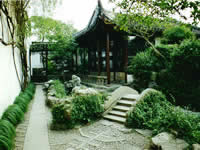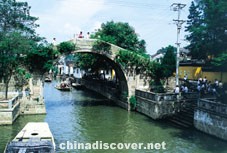Master of Nets Garden

The Master of the Nets Garden is among the finest gardens in Suzhou. It is located at Canglang District, Dai Cheng Qiao Road, No. 11 Kuo Jia Tou Xiang. It is recognized with other classical Suzhou gardens as a UNESCO World Heritage Site.
The Garden covers 5,400 sq.m. and is divided into two parts: the eastern house and the western garden. Half enclosed by a screen wall with a row of iron rings for tethering horses,and two alleyway side entrances, the front door faces south,having a pair of var. Pendular in front, and hairpin-like door ornaments above, and two huge blocks of stone carved in the shape of drums kept fast with the hands, placed one by its left side and another by its right side. This type of front door showing owner's rank at the court has become very rare now. On a north-south axis there are four successive buildings separated by garden courts,namely the front door hall, the sedan-chair hall, the grand reception hall and the two-storeyed tower.
Constructed in accordance with the strict regulations of feudalism, they are magnificent buildings with extraordinary furnishing and interior decoration. In front of the grand reception hall is a door with richly carved earthen ornamentation.
The two-storeyed tower at rear is the place where the family used to stay,and the hall in front is chiefly for reception,public celebrations and ceremonial observances. Every hall has a door or walk-way leading to the garden. It is a typical example of combining living quarters with a landscape garden in Suzhou.
The garden lies to the northwest of the house, making up four fifth of the total area. Quite different from the normal architecture in the east, the garden architecture enjoys a considerable degree of free.Varieties of building are laid out to meet the needs of reading, painting, viewing, resting, sipping tea.
The technique of emancipation by suppression and contrasting light with shade are remarkably employed to make the middle part of the garden appear more impressive that it is when seen alone.
The middle part of the garden has a pond in the center covering about 440 sq.m. with a small bay to the northwest and a streamlet to the southeast giving the impression of infinity. It is curved round by a roofed walkway ,natural-looking mountains made from yellowstones piled up in layers forming hollows and caverns within, a tiny arch bridge called "the Leading to Quietude",and a number of delicate and well-proportioned pavilions, namely the Washing-My-Ribbon Pavilion over the water, the Moon Comes with Breeze Pavilion, the Prunus Mume Pavilion and the Duck-Shooting Veranda.
The Washing-My-Ribbon Pavilion over the water is the best viewing place of the garden. The idea comes from a fisherman's song in the works of Mencius, saying ,"If the water of the Surging Wave River is clean, I wash the ribbon of my hat; if the water of the Surging Wave River is dirty, I wash my feet."
In sum, there are scenes beyond scenes, and gardens within the garden. Many buildings are perfectly well-spaced instead of being crammed. A small area of water and stone is made to seem large. Based on illusion, the garden is full of change, capturing the effect of boundlessness, and achieving a unity of part and whole. The Master-of-Nets Garden serves to illustrate how the few surpasses the many and the small exceeds the large.




